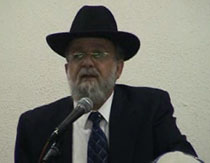Beit Midrash
- Sections
- Chemdat Yamim
- Bemare Habazak - Rabbis Questions
Answer: Setimat haposkim is a post-Talmudic tool for helping decide halacha. We have found several hundred occurrences of the phrase in the Bar Ilan Responsa Project, especially among Acharonim.
The thesis of setimat haposkim is that if a certain common halachic issue or a distinction in a halacha is not raised, or is raised in only a handful of sources, one can assume that the consensus of poskim opposes it. The logic is that if the matter had been accepted to a reasonable degree, it would have found its way into several rabbinic sourcesHow do we know, then, what the halacha is, when there are no sources on the case? Usually, one should assume that the simple understanding or practice is correct. If there is an accepted halacha but there is logic without sources to limit the halacha to certain cases, setimat haposkim indicates that there is no halachic distinction. Regarding a matter like the one you referred to, where the issue is whether to require a special act (e.g., of acquisition for the matza), setimat haposkim is a reason to not require an act that is not mentioned as necessary. Setimat haposkim is often used to reject a new stringency, as it would have been irresponsible for a large number of poskim to have omitted it, were it necessary. It can also be used to reject a novel leniency.
Scholars in many areas of research can use this tool. For example, if a researcher studying the history of a particular neurological disorder made an extensive study of medical records of a certain era and found no evidence of relevant symptoms, he might safely conclude that this disorder did not exist then or was extremely rare.
There are certain conditions that must be met in order to employ setimat haposkim. First, one must have searched through a sufficient number of sources. Sample size is always important, especially when drawing conclusions from what is not written. The necessary volume depends on a few factors. If the situation at hand is common, relatively fewer sources are needed. Regarding responsa literature, common issues would be expected to come up more often. Regarding codes, while codifiers cannot discuss every case, it is more important to discuss common issues.
Another factor is the proximity of the issue to topics in the literature. If there are detailed sources about cases similar to the issue at hand, the absence is more significant. Returning to our example, a medical textbook that surveys, say, 150 medical conditions can be ‘forgiven’ for not mentioning a given neurological disorder, but a detailed textbook on neurological conditions cannot.
One must be experienced and careful in using setimat haposkim and know how to analyze the background. In our medical example, perhaps in the studied era, the disorder was viewed as a psychological, not a neurological disorder, thus explaining its absence in the neurological contexts. Returning to halacha, perhaps the issue is common nowadays but was not in the past. For example, one should not dismiss pre-nuptial agreements due to a lack of source material on their past use since there were, in the past, fewer recalcitrant husbands and, consequently, a smaller need. Sometimes an issue is barely discussed because the answer was taken for granted. For example, the laws of a mechitza in shul became a relevant topic only when some people tried to do away with it and then only in certain circles. Previously, its existence and requirements were a given that did not raise halachic questions. Using grape juice for the Pesach seder was not discussed because grape juice was not available in the spring before the days of vacuum packing.
In our day and age, setimat haposkim is a more compelling tool than ever. We have access to far more seforim than our predecessors both because with every generation more works have been written and because we have easier access to more of them. There are works on virtually all topics that give summaries with extensive footnoting and indexing. Certainly, with powerful computer search engines that now exist, an experienced researcher should be more confident in coming to conclusions from what he does not find.

Bemare Habazak - Rabbis Questions (627)
Various Rabbis
20 - Emor Question
21 - Question Bechukotai
22 - Tetzaveh Question
Load More

Ask the Rabbi: Selecting Things to Use Later on Shabbat
Rabbi Daniel Mann | Iyar 5785

Ask the Rabbi: The Transition from Shabbat into Tisha B’av
Rabbi Daniel Mann | Av 5785

Ask the Rabbi: Wearing a Kippa in Today’s US Social Atmosphere
Rabbi Daniel Mann | Tammuz 5785

Ask the Rabbi: Giving a Tallit on a Sefer Torah to a Visitor
Rabbi Daniel Mann | Cheshvan 5786

Rabbi Daniel Mann

Obtaining Arba’ah Minim for the Sukkot after Shemitta
Tisheri 7 5776

Davening Early on Shavuot
Iyar 26 5777

Standing for Parents in our Times
5775


























